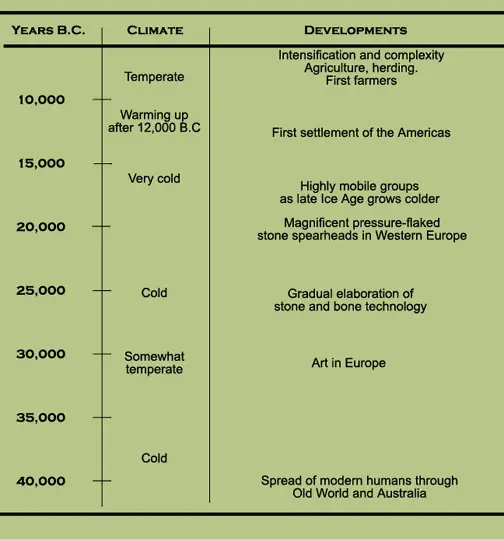Civilisation and climate change are closely connected. The Palaeolithic hunter gathers had occupied many landscapes, gathering food and hunting, but seemingly, they awaited the right conditions so they could settle down to a more sedentary life way. After about 8,000 years ago, agriculture expands quickly and we see villages develop into cities and the beginnings of urbanisation. Why is this so?
For much of the Pleistocene (1.6 million years ago – 10,000 years ago) the Earth’s climate was cold and dry, moving cyclically from gradual glaciation (sea levels dropping) to rapid deglaciation (sea levels rising). At the height of the last glaciation 16,000 years ago, sea levels were 130 metres (425 feet below current levels) and large areas of North America and Europe were covered in ice sheets.
By 12,000 years ago the glacial sheets were retreating and the climate began to slowly warm up, rainfall patterns changed and the carrying capacity for humans of the global landscape increased. The unpredictability of previous weather patterns gave way to more predictable seasonal resources, and humans for the first time had the capacity to generate surplus food. It is around the same time in the archaeological record, that we see a focus on agriculture and domestication due to this significant climate shift. Quite suddenly, and at multiple points around the globe agriculture and cities emerge in the archaeological record.

“For tens of thousands of years, human populations were miniscule and everyone lived from hunting and the gathering of plant foods. Survival depended on mobility and opportunism, on a flexibility of daily existence that allowed people to roll with the climatic punches – by moving away, hiving off families into new territories, or falling back on a cushion of less desirable food. Around 10,000 B.C., when farming began, anchoring permanent villages to their fields, the options afforded by mobility began to close. More people to feed, denser village populations; the risks were higher, especially when communities expanded to the limits of their land or when herds overgrazed the landscape.” (Fagan, B. 2004, The Long summer: How Climate Changed Civilization, Perseus Book Group, New York)

The archaeological record shows societies flourished once climatic conditions were right for agriculture, and we can begin to appreciate the importance of the link between civilisation and climate change. On understanding this we can also see how tenuous this link is, and how vulnerable humans are to global climate changes. When global population levels were low, and people moved across large territories in search of food there was both mobility and flexibility. If conditions changed, a group of people could move on to utilise resources in another area.
Today, in our heavily populated world we are tethered to our towns and cities, and inherently we are exposed to much higher risks from climate change than our forbears. Our human history is one of continual change and adaptation, let us hope that enough people begin to understand the urgent need to change the way we currently live. Deep changes are necessary to reduce our impacts on the climate and plan for a climate that is changing before our very eyes.
